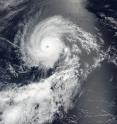NASA spies major Hurricane Georgette
Hurricane Georgette is a major hurricane in the Eastern Pacific Ocean. NASA-NOAA's Suomi NPP satellite provided a visible image of the powerful storm that showed a clear eye. On July 24, at 21:20 UTC (5:20 p.m. EDT) the Visible Infrared Imaging Radiometer Suite (VIIRS) instrument aboard NASA-NOAA's Suomi NPP satellite captured an image of Hurricane Georgette in the eastern Pacific Ocean that showed an open eye with strong bands of thunderstorms circling the center.
Shortly after Suomi NPP captured the visible image, Georgette's maximum sustained winds had increased to near 130 mph (215 kph) and Georgette became a category 4 hurricane on the Saffir-Simpson Hurricane Wind Scale.
Just 12 hours later, Georgette's eye became cloud-filled as the storm started to weaken. The National Hurricane Center (NHC) noted on July 24 at 11 a.m. EDT (1500 UTC) that "Georgette's small eye has become filled in infrared imagery and the coverage and symmetry of cold tops in the central dense overcast have decreased."
At that time the center of Hurricane Georgette was located near 17.5 north latitude and 127.3 west latitude. That's about 1,185 miles (1,910 km) west-southwest of the southern tip of Baja California, Mexico.
Maximum sustained winds have decreased to near 120 mph (195 kph). Georgette is major hurricane, a category 3 hurricane on the Saffir-Simpson Hurricane Wind Scale.
Georgette is a small hurricane. Hurricane-force winds extend outward up to 10 miles (20 km) from the center and tropical-storm-force winds extend outward up to 45 miles (75 km). The estimated minimum central pressure is 961 millibars.
Georgette is moving toward the northwest near 9 mph (15 kph) and this motion is expected to continue for the next couple of days.
NHC Forecaster Brennan said that quick weakening is expected as the cyclone will be moving over progressively cooler sea surface temperatures and into a drier and more stable air mass. NHC expects Georgette to become a remnant low in about 3 days, by July 28.
For updates on Georgette, visit the NHC website: http://www.nhc.noaa.gov.
Source: NASA/Goddard Space Flight Center
Articles on the same topic
- NASA sees compact Tropical Storm Frank weakening8 years ago
- Eastern Pacific storms Georgette and Frank see-saw in strength8 years ago
- NASA data show Hurricane Frank's fluctuation in strength8 years ago
- NASA scans Tropical Storm Frank's winds8 years ago
- NASA spots Tropical Storm Darby as warnings posted in Hawaii8 years ago
- NASA catches Estelle becoming post-tropical8 years ago
- NASA's GPM observes newly formed Tropical Storm Georgette8 years ago
- NASA spots 'hot towers' in intensifying Tropical Storm Frank8 years ago
Other sources
- NASA sees compact Tropical Storm Frank weakeningfrom Physorg8 years ago
- Satellite tracks the remnants of Tropical Storm Georgettefrom Physorg8 years ago
- Eastern Pacific storms Georgette and Frank see-saw in strengthfrom Physorg8 years ago
- NASA data show Hurricane Frank's fluctuation in strengthfrom Physorg8 years ago
- NASA scans Tropical Storm Frank's windsfrom Physorg8 years ago
- NASA spies major Hurricane Georgettefrom Physorg8 years ago
- Tropical Storm Darby bearing down on Hawaiifrom UPI8 years ago
- NASA catches Estelle becoming post-tropicalfrom Physorg8 years ago
- NASA spots Tropical Storm Darby as warnings posted in Hawaiifrom Physorg8 years ago
- NASA's GPM observes newly formed Tropical Storm Georgettefrom Physorg8 years ago
- NASA Spots "Hot Towers" in Intensifying Tropical Storm Frankfrom Physorg8 years ago
- GPM measured heavy rain in Tropical Storm Estellefrom Physorg8 years ago


